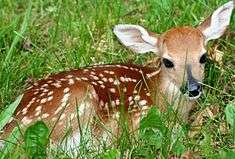Bambi effect
The "Bambi effect" is an objection against the killing of animals that are perceived as "cute" or "adorable", such as deer, while there may be little or no objection to the suffering of animals that are perceived as somehow repulsive or less than desirable, such as pigs or other woodland creatures.[1]

Referring to a form of purported anthropomorphism,[2] the term is inspired by Walt Disney's 1942 animated film Bambi, where an emotional high point is the death of the lead character's mother at the hands of the film's antagonist, a hunter known only as "Man".[3][4][5]
Effects
Some commentators have credited this purported effect with increasing public awareness of the dangers of pollution, for instance in the case of the fate of sea otters after the Exxon Valdez oil spill,[6] and in the public interest in scaring birds off airfields in non-lethal ways.[7] In the case of invasive species, perceived cuteness may help thwart efforts to eradicate non-native intruders, such as the white fallow deer in Point Reyes, California.[8] The effect is also cited as the anthropomorphic quality of modern cinema: most people in modern Western civilization are not familiar with wildlife, other than "through TV or cinema, where fuzzy little critters discuss romance, self-determination and loyalty like pals over a cup of coffee", which has led to influences on public policy and the image of businesses cast in movies as polluting or otherwise harming the environment.[9]
The effect was also cited in the events following a record snowfall in the U.S. state of Colorado in 2007, when food for mule deer, pronghorns, and elk became so scarce that they began to starve; the Colorado Department of Wildlife was inundated with requests and offers to help the animals from citizens, and ended up spending almost $2 million feeding the hungry wildlife.[10] Among some butchers, the Bambi effect (and in general, Walt Disney's anthropomorphic characters) is credited with fueling the vegetarian movement;[11] chefs use the term to describe customers' lack of interest in, for instance, whole fish: "It's the Bambi effect – [customers] don't want to see eyes looking at them".[12]
References
- Nash, Susan Smith (2006). Leadership and the E-Learning Organization. Texture. p. 222. ISBN 978-0-9712061-6-8.
- Petersen, Hanne; Birger Poppel (1999). Dependency, autonomy, sustainability in the Arctic. Ashgate. p. 286. ISBN 978-1-84014-701-8.
- "The Bambi Effect". Portland Mercury. Retrieved 2007-09-25.
This is the Bambi Effect: our adverse reaction to cute critters being harmed.
- "Anti-hunting sentiment on the wane". Times Community Newspapers. Archived from the original on 2006-04-23. Retrieved 2007-09-25.
Remarking on the "Bambi Effect," noted demographer Diane Crispell wrote: "Ever since (the Walt Disney classic movie) Bambi, hunters have been typecast in the media as villains who take shots at anything that moves for the sheer love of killing."
- Boardman, Robert; Debora VanNijnatten (2002). Canadian environmental policy: context and cases. Oxford UP.
- Keeble, John (1999). Out of the channel: the Exxon Valdez oil spill in Prince William Sound. Eastern Washington UP. pp. 4, 164. ISBN 978-0-910055-53-6.
- Davenport, Julia L. (2006). The ecology of transportation: managing mobility for the environment. Springer. p. 28. ISBN 978-1-4020-4503-5.
- Slobig, Zachary (2007-05-06). "Easy Target: There's a plan afoot to eradicate the white fallow deer in Point Reyes – but could there be another way to keep rangers, ranchers, animal lovers, Hindus and venison diners on the same side?". San Francisco Chronicle. Retrieved 2009-12-01.
- Polakovich, Gary (2001-03-27). "Column One: Seeing a Greener Big Screen; Erin Brockovich has plenty of company as films increasingly cast polluters as the villain. But businesses call the depictions slanted and say firms do their part for the environment". Los Angeles Times. p. A.1. Retrieved 2009-12-01.
- Irvine, Leslie (2009). Filling the Ark: Animal Welfare in Disasters. Temple UP. p. 128. ISBN 978-1-59213-834-0.
- Janssens, Emke (2008-11-21). "Meepraten: Bambi-effect". Slagerswereld. Retrieved 2009-12-01.
- Beale, Lewis (2004-04-02). "Turkeys on the menu: Chefs recall dishes they love – but customers hate". New York Daily News. Retrieved 2009-12-01.
Further reading
- Cartmill, M. (1993). A View to Death in the Morning: Hunting and Nature through History. Cambridge: Harvard UP.